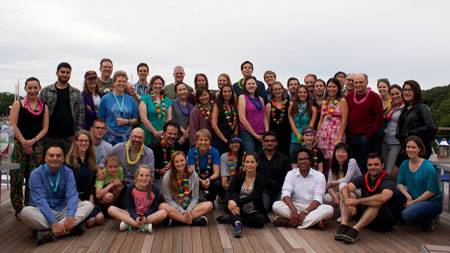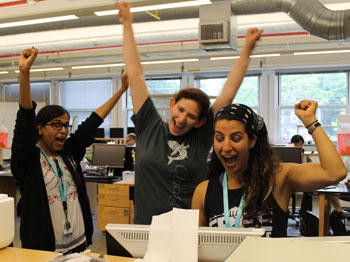Becoming Fearless: The Neural Systems and Behavior Experience

The following is an edited interview with André Fenton of New York University and Hans A. Hofmann of University of Texas, co-directors of the MBL Neural Systems and Behavior (NS&B) course.
This is your second year as NS&B co-directors, for which you spend eight weeks of your summer engaged in very intense work, far from your own research labs. Why do you do it?
ANDRÉ FENTON: We are building a community, helping the next generation of neuroscientists to think about neural systems, maybe even about the composition of life from [a neurobiological] point of view. Some of them will develop new tools that we will use in the course, so it is satisfying in that way. Also, I am learning a lot here – from faculty and from students. I am becoming a better, more knowledgeable scientist.
HANS HOFMANN: The MBL is an intellectually very stimulating environment in the summer. You can meet with a lot of colleagues, get to know new people, learn new things. More importantly, you can really work with students here. If anybody has an interest in mentoring the next generation of neuroscientists, this is the place where you can really have an impact. Historically, many of the leaders in our field have come through this course.
 The 2014 NS&B class with some of the course faculty and family members. Course co-director André Fenton is front row, fourth from right; co-director Hans Hofmann is back row, first from left. Credit: Mufaddal Baghdadwala
The 2014 NS&B class with some of the course faculty and family members. Course co-director André Fenton is front row, fourth from right; co-director Hans Hofmann is back row, first from left. Credit: Mufaddal BaghdadwalaWhat do students get from this course?
ANDRÉ FENTON: The course is structured so that students work with a series of model systems [experimental organisms], which stimulates them to think about the advantages and limitations of each system. If the students went through the course and used only one model system, they would come out thinking it is fantastic and has all the features they need. Instead, they come to recognize that there are powerful approaches and tools available in every system. That opportunity is very rare in your own laboratory or in your own department.
A good example is Ed Boyden (now an Associate Professor at MIT), who was a student in NS&B when he was starting his career in neuroscience. Someone like Ed would see that he could work with a simple, more tractable system like a leech or the worm C. elegans, in which every neuron is identifiable and the circuit of neural connections is essentially fully known, making it possible to control each neuron. He would also experience the frustrations of working with a mammal or a bird brain where the cell identities and the circuit wiring are not known, and yet these animals have very interesting behaviors to study, like song vocalization or motor control. Boyden went on to co-invent optogenetics [a technology for controlling neurons with light]; perhaps he was inspired by his experience at NS&B. Optogenetics is revolutionizing biology. It gives us tools and approaches that we needed and never imagined would be developed for use in vertebrate systems, but we could use in some invertebrate systems (or at least dream of using them).
HANS HOFMANN: We let the students mature and transform in this course. By the end of the summer, they can have very high-level conversations about almost any kind of problem in systems neuroscience. They will be able to come up with a good experimental plan and suggest a good model system. NS&B alumni appear to be more successful, in general, than the average graduate student or postdoc who does not take the course. A large fraction of them go on to eventually obtain faculty positions. They say that the course has been a life-changing and career-forming experience.
 From left: NS&B students Manisha Sinha from Indian Institute of Science, Hilary Katz from the University of Chicago, and teaching assistant Dalia Salloum from Rutgers University celebrate a successful experiment. Credit: Rayna Harris
From left: NS&B students Manisha Sinha from Indian Institute of Science, Hilary Katz from the University of Chicago, and teaching assistant Dalia Salloum from Rutgers University celebrate a successful experiment. Credit: Rayna HarrisLast year we sent a survey to the faculty mentors of all the students who had taken the course over the past six years. The response was tremendous. A number of faculty wrote that students coming back from the course had transformed the research program in their labs. New techniques were added and new research directions became possible. This is maybe the strongest endorsement for the course that we have.
ANDRÉ FENTON: You can actually see how students change during the course. The first time they present their work, they are very shy about it. But within 4 or 5 days they are standing up proudly, saying, “This is what I did, this is my interpretation, and this is the other interpretation.” By the end of the course they have become fearless. They can approach any problem in a rational, methodical way. They are confident, and that is part of what it means to become a scientist.
What do you expect from students who would like to participate in NS&B?
ANDRÉ FENTON: We expect that they be extraordinarily curious and open-minded. They clearly have to be intelligent, but a crucial part of being successful in this course is to socialize, to work in teams. We create an atmosphere that requires that students learn how to collaborate. It is one of the things we have been trying to emphasize – you have to work in community in order to identify problems, figure out how to simplify those problems, and ultimately understand those problems by working collectively using multiple approaches and techniques. That is very hard to do as an individual or even as an individual lab. So we expect from the students that they buy into this. It brings the whole group to a higher level of performance and achievement.
Wojciech Mikoluszko, a freelance journalist from Warsaw, Poland, was a 2014 fellow in the MBL’s Logan Science Journalism Program. As a recipient of a Woods Hole Fellowship from the program, he spent two weeks as an observer in the Neural Systems and Behavior course.